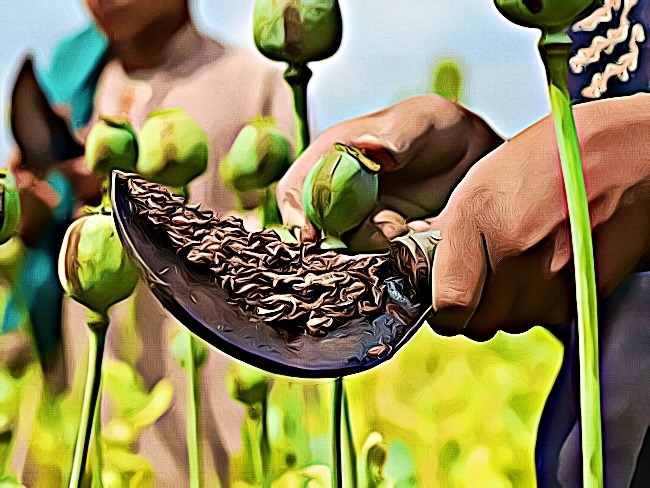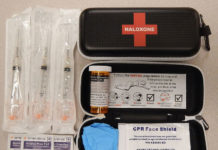The dried latex of the opium poppy (Papaver somniferum) seed pod is where one can obtain opium, a highly addictive narcotic substance. The morphine alkaloid present in opium serves as the source of heroin.
The unripe pod is traditionally split open, allowing the sap to seep out and dry on the outside of the pod.
The resulting yellow-brown latex, which is scraped off of the pod, has an unpleasant taste and varies in the amount of alkaloids it contains, including papaverine, morphine, codeine, and thebaine.
Fentanyl, methadone, oxycodone, and hydrocodone are additional synthetic or semisynthetic opium derivatives.
Opium is rarely grown and developed in the United States for illicit commercial usage. Latin America and Afghanistan are the main suppliers of goods to the United States.
Three-quarters of the world’s supply of heroin comes from Afghanistan, which is the center of opium cultivation globally.
What Are the Effects of Opium?
Every drug use entails some danger. When using any kind of medication, it’s crucial to use caution.
Everyone is affected by opium differently depending on the following:
- The individual’s height, weight, and health
- Frequency of use
- Whether or not other medications are consumed at the same time
- The amount consumed
- The potency of the medication (which varies between batches)
Possible immediate impacts include the following:
- Euphoria
- Relaxation
- Analgesia
- Slowed down and shallow breathing
- Reduced heart rate
- Weakened reflexes
- Temporary inability to eat
- Decrease in appetite
Regular opium usage may result in the following:
- Tolerance is the requirement of more to achieve the same result
- Irregular cycles and trouble getting pregnant
- A decline in sex desire
- Constipation
- Addiction to opium
You might overdose if you consume a lot of opium. If you or a loved one exhibits any of the following symptoms, call an ambulance right away (ambulance officers don’t need to engage the police).
The opium overdose symptoms include the following:
- Incredibly slow breathing
- Consciousness is lost
- Small pupils
Overdose without treatment can cause death and brain damage.
The danger of overdose is greatly increased when combining depressants with other drugs, such as alcohol and benzodiazepines, or multiple depressants like opium.
Opium and stimulants like cocaine or speed give your body opposing impulses, which can put a strain on your heart. The effects of opium and stimulants may also be masked by one another when combined, raising the danger of an overdose.
Risks
When used in high dosages, opium can cause a person’s breathing to become so sluggish that they may become unconscious or perhaps pass away.
Constipation, nausea, and disorientation are other side effects. The mouth and nasal mucous membranes may become dry after using the medication.
When coupled with other medicines or alcohol that also depress the central nervous system—such as barbiturates, benzodiazepines, antihistamines, or general anesthetics—the risk of life-threatening respiratory depression increases.
Drug tolerance, which results in needing more of the drug to have the same euphoric effects, can develop following repeated use.
Additionally, it might result in physical dependence and addiction. If long-term use is cut back or stopped, withdrawal symptoms may develop.
Background
The earliest known accounts of the production and use of opium date to 3400 B.C. It served as a strong pain reliever for the ancient Greeks and Romans.
The Sumerians called it the “joy plant,” or Hul Gil, and it was cultivated in Southeast Asia.
Opium was also farmed by the Assyrians and the Egyptians. It was traded through the Silk Road, a network of trade routes between Europe and China, and it even played a part in the Opium Wars of the eighteenth century.
Opium dens, which were marketplaces for the trade of opium, existed throughout the world but were particularly prevalent in Southeast Asia, China, and Europe.
Opium dens appeared in the west of the country in the 1800s, including in San Francisco’s Chinatown, and moved to the east to New York.
Due to its intoxicating and painkilling properties, Chinese immigrants who came to the United States for railroad and gold rush jobs frequently took their opium with them.

How Is Opium Administered?
Opium can be consumed as a tincture, smoked, eaten raw or as a tablet, or taken orally. Heroin production requires opium, which can be converted into heroin.
Opium can be consumed orally, intravenously, or as pills. Additionally, opium is misused in conjunction with other substances.
For instance, “Black” combines methamphetamine, opium, and marijuana, and “Buddha” is a strong substance.
What Drugs Have Opium in Them?
Opioids are recommended for a variety of medical conditions. Antagonists and agonists are the two basic categories for this kind of medication.
Although there is still a chance of abuse, antagonists like naltrexone and naloxone are thought to be less addictive than agonists.
They are frequently employed to aid in the detoxification procedure, which frequently constitutes the initial phase of addiction treatment.
By interacting with particular receptor sites in the brain, agonists imitate the effects of endorphins that the body naturally produces. Drugs with the strongest effects and those most frequently used in medical settings, such as morphine and fentanyl, are antagonists.
The potential for abuse and addiction is very high for many of the chemicals in this category. Hydrocodone, Oxycodone, Heroin, and Buprenorphine are further agonists.
The list below includes the most typical opiate agonists.
- Codeine
In comparison to other opioid painkillers, codeine is less strong and designed to treat mild to moderate pain and coughing. It is simple to obtain a prescription, and some over-the-counter medications include it.
Young adults frequently abuse codeine, which is frequently mixed with sweet beverages to make “Purple Drank” or “Sizzurp.”
- Darvocet/Darvon
The FDA has officially outlawed the propoxyphene-based painkillers Darvocet and Darvon, which caused tens of thousands of hospital admissions and fatalities during their peak.
There is still a black market for these pharmaceuticals even if prescriptions for them are no longer written.
- Demerol
Demerol is a narcotic that is used to treat moderate to severe pain. However, it is less frequently recommended today due to its high risk of addiction.
Meperidine, often known as Demerol, is a drug with euphoric effects akin to morphine.
- Dilaudid
Dilaudid is a potent form of painkiller that is occasionally referred to as “Hospital Grade Heroin.” Abusing Dilaudid, which comes in extended-release tablets, can cause breathing difficulties or even death.
- Fentanyl
Fentanyl, a synthetic painkiller with a potency of up to 100 times greater than morphine, is only administered in cases of extreme pain.
Fentanyl can swiftly cause overdose and other harmful side effects when combined with other painkillers like heroin.
- Hydrocodone
Hydrocodone is a key component of several potent painkillers, including Vicodin. The FDA has also approved drugs that contain only pure Hydrocodone, albeit it is generally coupled with Ibuprofen or Acetaminophen.
- Methadone
Methadone, an opioid used to treat moderate to severe pain, is also used to help people who are addicted to heroin or other drugs like it control their urges.
Methadone remains a highly addictive medication despite being used to treat other addictions.
- Morphine
Morphine has been hailed as a miracle drug for those with unbearable chronic pain. It is also one of the most addictive drugs ever discovered and is to blame for many unintentional drug-related fatalities around the country.
- Oxycodone
Brand names for oxycodone include OxyContin and Percocet. It is a pain reliever that is frequently prescribed and has a significant risk of abuse.
Conclusion
Opium is a highly addictive substance that has been used for centuries for its pain-relieving and euphoric effects. Although it is legal in some countries for medical purposes, it is illegal in most countries, and its use is tightly controlled.
As mentioned above, opium abuse can lead to a number of serious health problems. Please seek out professional assistance if you or someone you know is battling opium abuse.
















